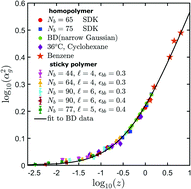Universality of the collapse transition of sticky polymers†
Abstract
The universality of the swelling of the radius of gyration of a homopolymer relative to its value in the θ state, independent of polymer–solvent chemistry, in the crossover regime between θ and athermal solvent conditions, is well known. Here we study, by Brownian dynamics, a polymer model where a subset of monomers is labelled as “stickers”. The mutual interaction of the stickers is more attractive than those of the other (“backbone”) monomers, and has an additional important characteristic of “functionality” φ, i.e., the maximum number of stickers that can locally bind to a given sticker. A saturated bond formed in this manner remains bound until it breaks due to thermal fluctuations, a requirement which can be viewed as an additional Boolean degree of freedom that describes the bonding. This, in turn, makes the question of the order of the collapse transition a non-trivial one. Nevertheless, for the parameters that we have studied (in particular, φ = 1), we find a standard second-order θ collapse, using a renormalised solvent quality parameter that takes into account the increased average attraction due to the presence of stickers. We examine the swelling of the radius of gyration of such a sticky polymer relative to its value in the altered θ state, using a novel potential to model the various excluded volume interactions that occur between the monomers on the chain. We find that the swelling of such sticky polymers is identical to the universal swelling of homopolymers in the thermal crossover regime. Additionally, for our model, the Kuhn segment length under θ conditions is found to be the same for chains with and without stickers.



 Please wait while we load your content...
Please wait while we load your content...